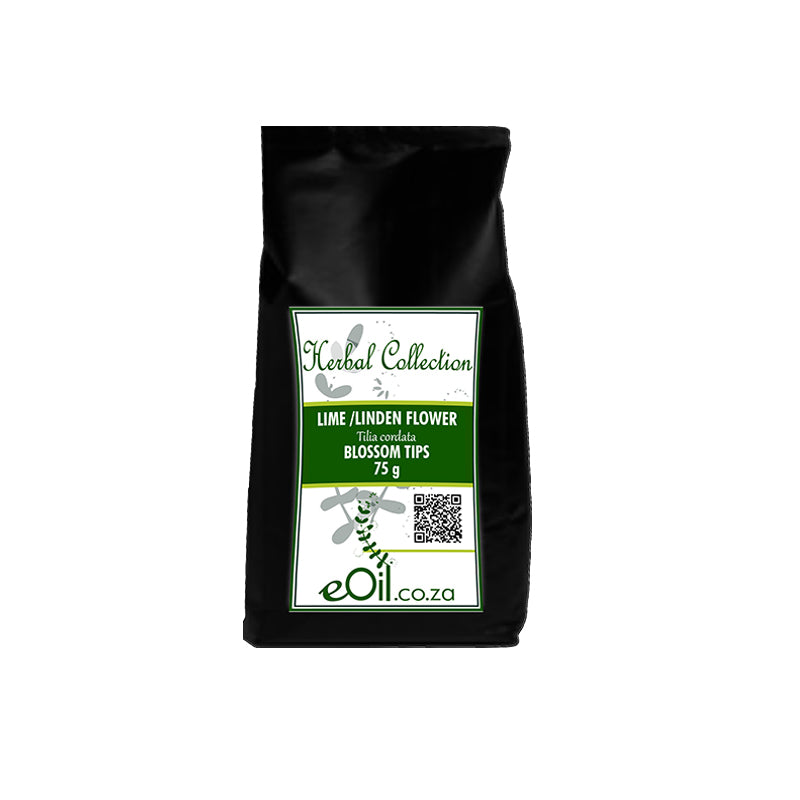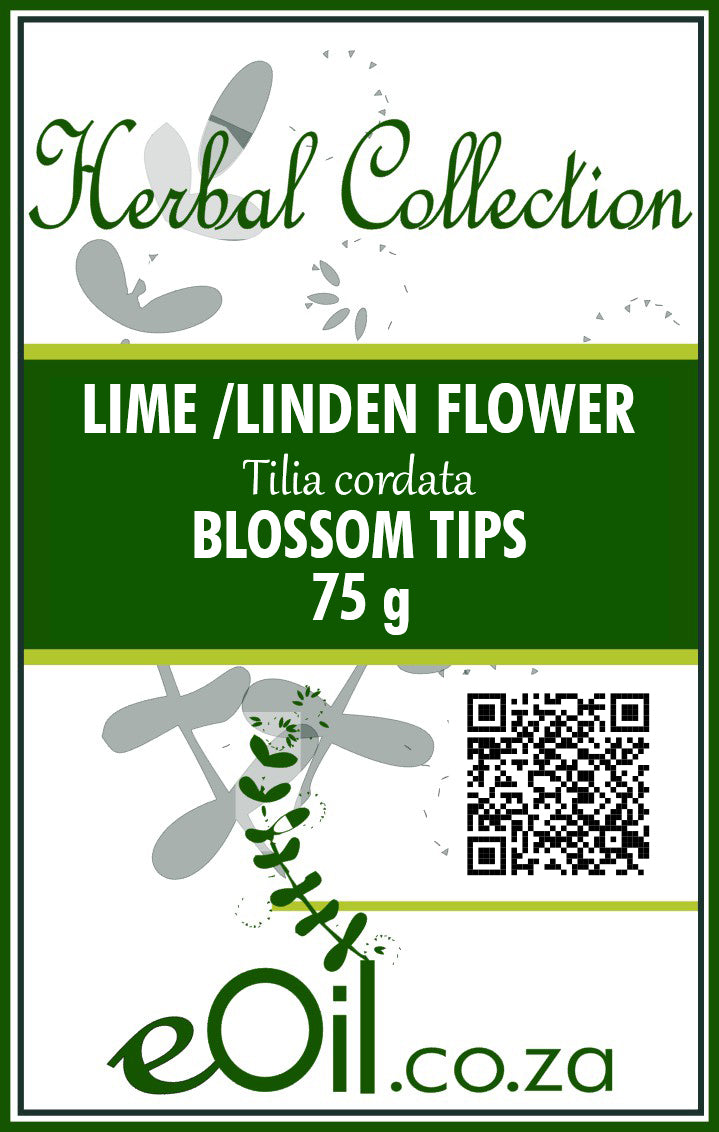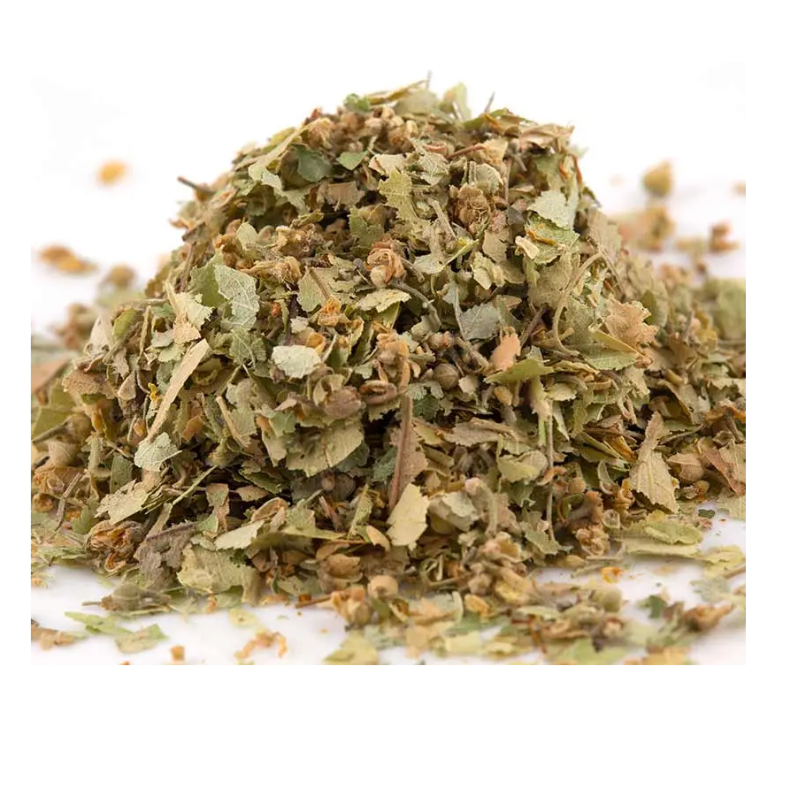Lime/Linden Flower Blossom cut - Herbal Collection
Lime/Linden Flower Blossom cut - Herbal Collection - 75 GR is backordered and will ship as soon as it is back in stock.
Description
Description
TRADITIONALLY USED FOR
May help with
- promote relaxation.
- fight inflammation.
- reduce mild pain.
- have diuretic effects.
- Linked to lower blood pressure.
- sleep.
- Soothes your digestive tract.
- Easy to add to your diet.
INFORMATION
Source : http://www.wikiphyto.org/wiki/Tilleul
Reference on http://www.wikiphyto.org
Translation in English by Google Translate (go to the page of the source linked | on Chrome cellphones go on the 3 dots on the top right and select translate in your preferred language | on laptop right click your mouse and select option translate when hoovering on the page
plant name
Linden
International Latin denomination
- Tilia cordata Mill. ( small-leaved lime ) = Tilia parvifolia Ehrh. ex-Hofm. = Tilia ulmifolia Scop. = Tilia sylvestris Desf.
- Tilia platyphyllos Scop. ( large-leaved lime )
- Tilia tomentosa Moench. = Tilia argentea DC
botanical family
Tiliaceae , according to the classic morphological classification after Cronquist.
- The genus Tilia is now classified in the family Malvaceae according to the APG III phylogenetic classification (2009)
Description and habitat
- Large trees with gray and smooth bark, heart-shaped leaves, present in the woods of all Europe and Asia Minor
- Grown in North America
- Pleasantly fragrant, pentameric flowers, grouped in cymes
- The inflorescence is carried by a peduncle fused to a long membranous bract, colorless or greenish yellow
- The fruit is an indehiscent capsule ranging from 6 mm ( Tilia cordata ) to 8-10 mm ( Tilia platyphyllos )
- Linden trees are often hybrids, all European species would be infertile
- Common species:
- Small-leaved Tilia cordata Mill.= Tilia parvifolia Ehrh. ex-Hofm.
- Large-leaved Tilia platyphyllos Scop.
- Their hybrid, Tilia vulgaris Hayne = Tilia x europea = Tilia intermedia DC
- Dutch linden Tilia tomentosa should be discarded for medicinal use (except buds)
- A robust species, lime requires deep, divided, cool soil. Its reddish white wood is of mediocre quality, it can live for several centuries, it lives in the calcareous ash oak forest, in the sub-mountain maple ash forest and in the calcareous sessiliflorous oak forest.
History and tradition
- The legend says that it was the leaf of a heart-shaped lime tree that landed on Siegfried's back, the only vulnerable place in his body after he bathed in the blood of the vanquished dragon (saga of the Nibelungen)
- Many lime trees are of distant origin ( Tilia chinensis Maxim. and Tilia mandchurica Rupr.) and of unequal quality (one often puts some in the infusettes); with regard to the sapwood, discard the one that is too light in color sometimes coming from these species (much less rich in active ingredients)
Parts used
- Inflorescences, leaves and bracts
- Sapwood
- buds
Dosage forms available
- Mother tincture of inflorescence with its bract
- Glycerine macerate of buds ( Tilia tomentosa )
- Herbal tea of bracts and flowers (infusion) of Tilia cordata or Tilia platyphyllos
- Sapwood herbal tea (decoction) for Tilia sylvestris harvested at altitude (between 1000 and 1200 meters for the "cru" of Roussillon)
Usual dosages
- Glycerine macerate 50 to 100 drops in adults (up to one teaspoonful), one drop per kg of weight and per day in children
- Wild linden sapwood from Roussillon: 40 grams for one liter of water; boil for 10 minutes over low heat; infuse one hour. Drink during the day, 10 days a month for three months
- Bracts and flowers: 15-minute infusion, drink in the evening before bedtime, or in baths (children)
Composition
Main components of the plant
- Inflorescences:
- Flavonoids : tiliroside (= p-coumaroyl-6”-glucoside-3-kaempferol ), kaempferol , hyperoside , rutoside , rhamnosyl-7-kaempferol , quercitroside and isoquercitroside
- Proanthocyanidins and leucoanthocyanidins , tannins (2%)
- Sesquiterpene alcohol , farnesol in flower
- Mucilage (10%): arabinogalactans , uronic acids
- Caffeic acid , p-coumaric acid , chlorogenic acid
- Essential oil (0.02 to 0.1%) with monoterpenes ( linalool , geraniol , 1,8-cineole , carvone , camphor , thymol , carvacrol )
- Sapwood:
- Acids phenols , tannins , coumarins ( fraxoside , esculoside ), amino acids and phloroglucinol
Main components of buds or young shoots
- Flavonols ( quercetin , kaempferol , apigenin derivatives ), hydroxycinnamic acids [1] , farnesol , mucilages , flavonoids , amino acids [2]
Main components of essential oil
- Oxygenated monoterpenes and sesquiterpenes : linalool , geraniol , farnesol , camphor , carvone , 1,8-cineole
- Bracts: phenylacetaldehyde and other aldehydes
- Flowers: monoterpene carbides
- Buds: farnesol , mucilages , in greater quantity in Tilia tomentosa than in Tilia cordata and Tilia platyphyllos [3]
Properties
Plant properties
- Inflorescences:
- Sedative [4] ( essential oil ), anxiolytic ( GABA -ergic by the aqueous extract) [5]
- Musculotropic spasmolytic
- Diuretic and hypotensive
- Sedative and antispasmodic ( farnesol ), ligand for benzodiazepine receptors [6]
- A related species, Tilia americana var. mexicana , of similar composition, possesses analgesic activity, quercetin is partly responsible for this pharmacological activity probably mediated by serotonin 5-HT1A receptors [7] , with antidepressant activity [8] involving the serotonergic system ( tiliroside , quercetin glucosides , quercitrin , rutin , kaempferol ) [9] , with anxiolytic and sedative effect involving GABA, benzodiazepine receptors and serotonergic 5HT1A receptors ( quercetin, rutin , isoquercitrin ) [10]
- Sheets :
- Analgesic and anti-inflammatory ( kaempferol-3,7-O-alpha-dirhamnoside , quercetin-3,7-O-alpha-dirhamnoside ) [11]
- Sapwood:
- Choleretic ( fraxoside , esculoside ), antispasmodic ( phloroglucinol ), coronary dilator and hypotensor
- Locally: softening, antipruritic
Bud properties
- Anxiolytic and sedative according to Tétau [12] , effects objectified by the spontaneous mobility test and the hole board test in mice
- Mild hypnosis (sleep inducer), effect demonstrated by the barbiturate narcosis potentiation test [2]
- Antispasmodic
- Rich in farnesol , a terpene with sedative neuro-regulatory properties
Properties of essential oil
Directions
Indications of the whole plant (phytotherapy)
- Inflorescences:
- Anxiety, minor sleep disturbances, spasms (even externally in baths)
- Psychologically, the symbolism of betrayal is very present (see the theme of Siegfried in the Nibelungen saga, "broken heart")
- Dermatological conditions, pruritus, eczema, in local baths
- Sapwood:
- Biliary dyskinesias, migraines and hepatobiliary disorders, slow digestion, high blood pressure
- Phloroglucinol is powerfully antispasmodic ( it is the active ingredient of Spasfon®, which is used in hepatic, renal colic, dysmenorrhea).
- Esculoside (a coumarin ) is venotonic and vasculoprotective. Fraxoside ( coumarin ) is anti-inflammatory and analgesic
Indications of the bud (gemmotherapy)
- Like Acer campestre , Tilia has no isolated determining action except mild antispasmodic and hypnotic action [13]
- With Acer campestre ill-defined anxiety neurosis
- With Ilex aquifolium epilepsy, petit mal by brief suspension of consciousness (absences of 5 to 15 seconds) with simple automatisms but without memory (see Ficus carica )
- Complementary remedies
- tree stratum
- Shrub layer
- Cytological and coagulation action
- Mild myelogrammic activity stimulation of granulopoiesis
- Activity on coagulation decreases transverse constants and slightly lengthens longitudinal constants
- Anxiolytic activity demonstrated in animal models
- Potentiation of hypnotics, increased ability to fall asleep
- It is not a sleeping pill but a sleep inducer without contraindication (pregnant women, children, old people)
- Does not alter the dream function
- Dosage 50 to 100 drops in adults (up to one teaspoonful), one drop per kg of weight per day in children
- (Caution sometimes reversal of effect: in this case reduce the doses)
Specific indications of essential oil (aromatherapy)
Known or suspected mode of action
- Phloroglucinol ( triphenol ) is powerfully antispasmodic
- Esculoside ( coumarin ) is a vasculoprotective veinotonic
- Fraxoside ( coumarin ) is anti-inflammatory and analgesic
- Farnesol ( sesquiterpene alcohol ) is sedative and antispasmodic
Usual formulations
- Wild linden sapwood ( Tilia sylvestris ) from Roussillon la Gravelline®: 400 grams. Count 40 grams for a liter of water; boil for 10 minutes over low heat; infuse one hour. Drink during the day, 10 days a month, for three months
- Linden bracts ( Tilia cordata or Tilia platyphyllos ): A pinch for a cup of boiling water, infuse 10 to 15 minutes, drink in the evening one hour before bedtime
- Tilia tomentosa Buds glycerine macerate 1 DH: 100 drops at bedtime in a glass of water or herbal tea (adult); 1 drop per kg of body weight for the child, in half a glass or a bottle of water
- General bath with linden bracts: A handful in a liter of boiling water, infuse 15 minutes, after filtration pour the herbal tea into a hot bath, in the evening
Regulations
- French Pharmacopoeia list A (sapwood, inflorescence)
Possible side effects and precautions for use
- Avoid in case of large urinary and gallstones
Bibliographic references
- Go↑ Ieri F, Innocenti M, Possieri L, Gallori S, Mulinacci N. Phenolic composition of "bud extracts" of Ribes nigrum L., Rosa canina L. and Tilia tomentosa M. J Pharm Biomed Anal. 2015 Nov 10;115:1-9. doi: 10.1016/j.jpba.2015.06.004. PMID 26135753
- ↑Go to :2.0 and 2.1 Viriot Anne-Claire. An update on gemmotherapy in 2012. Pharmacy thesis, Toulouse, 2015
- Go↑ DOLISOS. Tilia tomentosa buds. Virtues known for years. Today pharmacological evidence. Homeopathic Pharmacological Laboratories (LPH) DOLISOS Paris, 1980
- Go↑ Coleta M, Campos MG, Cotrim MD, Proença da Cunha A. Comparative evaluation of Melissa officinalis L., Tilia europaea L., Passiflora edulis Sims. and Hypericum perforatum L. in the elevated plus maze anxiety test. Pharmacopsychiatry. 2001 Jul;34 Suppl 1:S20-1. PMID 11518069
- Go↑ Fleurentin Jacques. Plants that heal us. Ed. West France. 2007.
- Go↑ Viola H, Wolfman C, Levi De Stein M, Wasowski C, Pena C, Medina J. H, Paladini AC Isolation of pharmacologically active benzodiazepine receptor ligands from Tilia tomentosa (Tiliaceae). Journal of ethnopharmacology, 1994, vol. 44, no.1, p. 47-53 [1]
- Go↑ Martínez-Hernández, GB, Jiménez-Ferrer, E., Román-Ramos, R., Zamilpa, A., González-Cortazar, M., León-Rivera, I., ... & Herrera-Ruiz, M. (2021). A mixture of quercetin 4′-O-rhamnoside and isoquercitrin from Tilia americana var. mexicana and its biotransformation products with antidepressant activity in mice. Journal of Ethnopharmacology, 267, 113619.
- Go↑ Chávez-Morales, Y., Jiménez-Ferrer, E., Martínez-Hernández, GB, Tortoriello, J., Román-Ramos, R., Zamilpa, A., & Herrera-Ruiz, M. (2019). Effect of Standardized Fractions and Tiliroside from Leaves of Tilia americana on Depression Tests in Mice. Iranian journal of pharmaceutical research: IJPR, 18(4), 1931.
- Go↑ Noguerón-Merino, MC, Jiménez-Ferrer, E., Román-Ramos, R., Zamilpa, A., Tortoriello, J., & Herrera-Ruiz, M. (2015). Interactions of a standardized flavonoid fraction from Tilia americana with Serotoninergic drugs in elevated plus maze. Journal of ethnopharmacology, 164, 319-327.
- Go↑ Aguirre-Hernández, E., González-Trujano, M., Terrazas, T., Herrera Santoyo, J., & Guevara-Fefer, P. (2016). Anxiolytic and sedative-like effects of flavonoids from Tilia americana var. mexicana: GABAergic and serotonergic participation. Mental Health, 39(1), 37-46.
- Go↑ Toker G, Küpeli E, Memisoğlu M, Yesilada E. Flavonoids with antinociceptive and anti-inflammatory activities from the leaves of Tilia argentea (silver linden). J Ethnopharmacol. 2004 Dec;95(2-3):393-7. PMID 15507365
- Go↑ Vise Max. New gemmotherapy clinics. Ed. Similia, Paris. 1987
- Go↑ Henry Pol. Gemmotherapy, therapy with plant embryonic extracts. Author's edition. Brussels, 1982.
- Wichtl Max, Anton Robert. Therapeutic plants: Tradition, officinal practice, science and therapy. Ed. Tec & Doc. Cachan. 1999. p. 559
- Bruneton J. Pharmacognosy, Phytochemistry, Medicinal Plants. Ed. Tec and Doc. 1997. p. 103
- Lanza JP, Steinmetz MD, Lavaivre-Pierlovisi M. Pharmacodynamic action and toxicity of aqueous extracts of lime tree Tilia sylvestris [in French]. Plants Med Phytoter 1982;16:129–136.
- Peev C, Dehelean C, Antal D, Feflea Ş, Olariu L, Toma C. Tilia tomentosa foliar bud extract: phytochemical analysis and dermatological testing. Studia Universitatis Vasile Goldis Arad, Seria Stiintele Vietii 2009 Vol. 19 No. 1 pp. 163-165 Full text
- Toker G, Memisoglu M, Yesilada E, Aslan M. Main Flavonoids of Tilia argentea DESF. former DC. Leaves. Turk J Chem 28 (2004), 745–749.
CAUTION
Store in a cool, dry place, away from light. Keep tightly closed, away from the reach of Children and pets.
Do not exceed the daily dose.
This product is not intended to prevent or cure any form of illness or disease.
If you are pregnant or nursing ; If you have a medical condition or are in the course of medical treatment ; If you are programmed for theater/operation in the near future, please consult your healthcare practitioner before using this product.
This product cannot replace a varied and balanced diet and a healthy lifestyle.
This product has not been evaluated by the SAHPRA for its quality, safety or intended use.
For More Information please check our General Safety Herbal products Page






